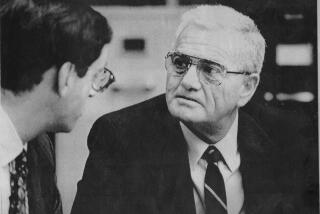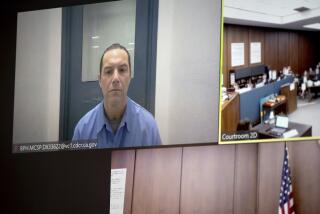Shoe Print at Crime Scene Not Lisker’s, FBI Confirms
- Share via
Experts at the FBI crime lab in Quantico, Va., have determined that a bloody shoe print used to help convict a San Fernando Valley teenager of killing his mother 22 years ago was not made by the teen’s shoes.
FBI analysts also determined that the shoes worn by Bruce Lisker, now 40, did not match an apparent shoe impression found behind his mother’s right ear.
The findings, which strongly suggest the presence of another suspect, confirm the earlier work of an analyst in the Los Angeles Police Department’s crime lab.
David Cunningham III, the outgoing president of the civilian Police Commission, which oversees the LAPD, said the bureau’s findings have convinced him that the department should reopen its investigation into the 1983 slaying.
“I absolutely think it warrants further investigation,” Cunningham said.
Prior to leaving the commission this week, Cunningham asked department officials to press forward on the case, but he said they were non-committal. Fearing the matter may get dropped, Cunningham said he had written to incoming commissioners appointed by Mayor Antonio Villaraigosa, offering to brief them on important matters, including the Lisker case.
“I hope that they will recognize that this is an important issue,” he said.
Only one commissioner, Alan J. Skobin, will remain on the panel from the board appointed by former Mayor James K. Hahn. He and four new commissioners will hold their first meeting next week.
One of the those commissioners, John W. Mack, said in a brief interview Wednesday that he was troubled by what he knew of the case and planned to “study up” on the matter.
“On its face, it’s very disturbing to think that an innocent man might be in prison,” said Mack, former president of the Los Angeles Urban League.
The FBI’s findings, he said, “add a lot of credence to this person’s innocence.”
William Genego, one of Lisker’s attorneys, said the FBI’s results further supported his client’s claims of innocence.
He said LAPD officials “have been told twice that what they told the jury is absolutely, indisputably false, and I would hope they would not have to be told a third time. Someone should take responsibility for correcting the injustice that resulted from that false information.”
Genego said he hoped the new Police Commission would follow through on Cunningham’s desire to reopen the case.
Deputy Chief Gary Brennan, who oversaw an internal review of the Lisker case, could not be reached for comment.
Brennan said in June, however, that the new shoe print evidence did not mean that Lisker had been falsely convicted. He said the LAPD had no plans to further investigate the case.
“An innocent man is not in prison,” Brennan said. “If we thought there was, we would continue to press forward in the interest of justice.”
Genego said there was a difference between what the police may believe and what the evidence supports.
“Whatever they may subjectively believe is not a basis for keeping Bruce Lisker in jail,” Genego said.
Dorka Lisker, 66, was fatally beaten and stabbed in her Sherman Oaks home on March 10, 1983.
Her son, Bruce, then 17, told police that he had returned home to find his mother near death and called paramedics for help.
Lisker, who had a history of drug abuse and fighting with his mother, immediately became the prime suspect.
He was arrested the day of the killing and has been behind bars ever since, having been sentenced to 16 years-to-life in prison.
Over the years, he twice confessed to the killing but now says he confessed out of desperation, to minimize his time behind bars for a crime that he did not commit.
In May, The Times published an article detailing new and previously overlooked evidence that raised doubts about Lisker’s conviction.
Even the prosecutor who convicted him told reporters that he had developed “reasonable doubt” about Lisker’s guilt.
The evidence included a bloody shoe print left in the bathroom of the Lisker home. At trial, the prosecutor said Lisker had left the shoe print.
But last year, an LAPD crime lab analyst determined that the print did not come from Lisker’s Pacer tennis shoes.
At the request of Times reporters, the same analyst determined that the shoe print impression found on Dorka Lisker’s shaved head during an autopsy was “similar in size and dimension” to the mystery shoe print in the bathroom.
The findings bolstered Lisker’s statements that he had returned home to find his mother near death, and that the assault had been committed by an unknown intruder.
In June, LAPD officials asked the FBI for a second opinion on their own analyst’s work. The FBI report, a copy of which was obtained by The Times, confirmed that neither the print in the bathroom nor the mark on the victim’s head, were made by Lisker’s shoes. The report does not address whether the two prints were made by the same shoe or whether the impression near the victim’s ear was made by a shoe.
Lisker, in a telephone interview from Mule Creek State Prison, said Wednesday that he was pleased -- but not surprised -- by the FBI’s findings.
“I wasn’t worried,” he said. “It’s one of the benefits of having truth on your side.”
Last month, a U.S. magistrate judge found that Lisker had made a persuasive “preliminary” case that “he is innocent of the crime for which he has been convicted.” As a result, he ordered an evidentiary hearing for October to further consider his claim of innocence, a development that legal experts said was rare.
Buoyed by the recent attention to Lisker’s case, his stepmother, Joy Mitchell Lisker, has launched a letter-writing campaign aimed at persuading Los Angeles County Dist. Atty. Steve Cooley to join defense attorneys in seeking to have Lisker’s conviction overturned.
“The D.A. has the power to do this,” Joy Lisker said in a letter to Lisker’s supporters. “Government officials pay attention to letters from the public. It’s time to create an outcry from those of us who care.”
Sandi Gibbons, a spokeswoman for Cooley, said the district attorney’s office is monitoring the Lisker case.
“The district attorney’s office has been in contact with the California attorney general’s office, which is handling this matter in U.S. District Court,” Gibbons said. “We will take the proper action when this latest legal challenge is resolved.”
More to Read
Sign up for Essential California
The most important California stories and recommendations in your inbox every morning.
You may occasionally receive promotional content from the Los Angeles Times.














